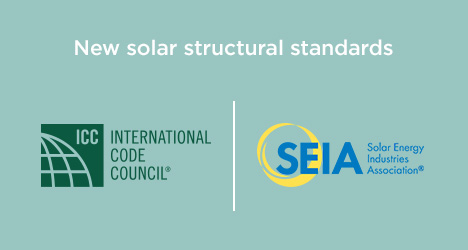Working with EPCs — End-to-End Renewable Energy Engineering Learn More
Proposed increase in structural standards for new solar facilities discussed at ICC conference

International Code Council members have been asked to vote on a code proposal from FEMA for the 2024 International Building Code S76-22 that would require solar, storage, and wind projects to meet structural Risk Category (RC) 4 requirements. RC4 is the most stringent category and would require an enormous jump in the cost of construction due to increased steel and concrete needed, likely canceling multiple gigawatts of clean energy projects. Most large-scale photovoltaic facilities are currently RC1, and nearly all wind turbine facilities are RC2.
Improving grid reliability
FEMA’s proposal stems from a desire to improve grid reliability, particularly with the increasing number of natural disasters of higher severity the country is experiencing due to climate change. However, renewable energy is widely recognized as a critical element of both a more reliable grid and the fight against climate change. With the RC4 requirements significantly raising the cost of constructing clean-energy facilities, a compromise solution is needed to keep renewable energy facilities being built.
Public input
The public hearings for this proposal were held at the ICC’s Annual Conference in Louisville, Kentucky in September. Blymyer’s Mike Rantz and Greg Mazur were asked by the Solar Energy Industries Association (SEIA) to attend as industry representatives, to provide support.
SEIA alternative proposal balances reliability and feasibility
Over 300 clean energy companies are supporting compromise proposals put forth by SEIA and the Distributed Wind Energy Association (DWEA). SEIA’s proposal includes a provision for solar projects to be designated as Risk Category 2 and ICC voted in support of this. It contends that solar arrays pose little risk to people, and they continue to produce power through severe weather events and natural disasters. The SEIA proposal balances a significant increase in the structural requirements for solar facilities with enough breathing room for project construction to move forward.
“While we understand FEMA’s goal of increasing grid reliability, requiring Risk Category 4 standards for new PV projects was too stringent and would eliminate the feasibility of many new solar facilities,” said Blymyer President Mike Rantz. “We attended the meeting to support a compromise solution that moves everyone’s objectives forward.”
Director of Engineering Greg Mazur added, “This compromise solution, supported by FEMA, will ensure more PV facilities are built, which will ultimately result in greater grid stability, while also giving these facilities more resistance to the effects of natural disasters.”
Unfortunately, the standards for wind projects moved to RC4 from RC1, which is going to have a deleterious effect on new wind projects, particularly on the Gulf Coast and in the Southeast US.
Although this is only a partial win for renewable energy, the adoption of SEIA’s compromise solution is good news, and Blymyer looks forward to being part of bringing more and larger PV projects to fruition.